Key takeaways
- French photography captures the essence of landscapes, blending culture and nature to evoke emotions and tell stories.
- Landscape photography serves to inspire conservation and appreciation for the natural world while connecting viewers to their surroundings.
- Effective techniques, such as the rule of thirds and shooting during golden hours, enhance composition and impact in landscape photography.
- Essential equipment, including tripods and wide-angle lenses, significantly contributes to capturing detailed and vibrant landscapes.
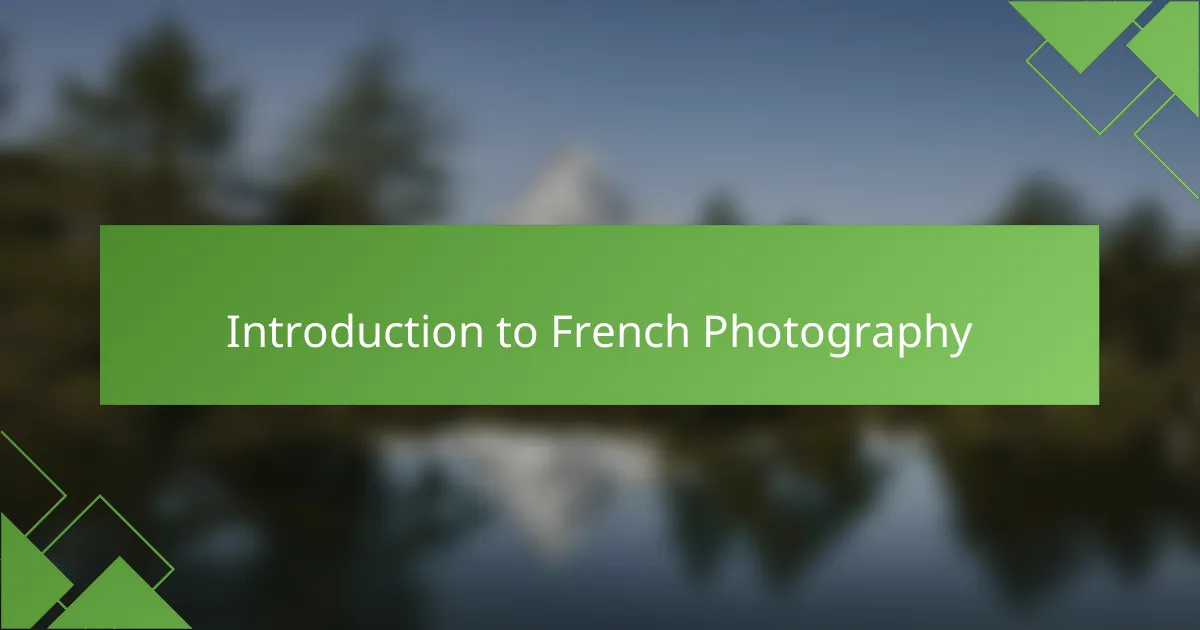
Introduction to French Photography
French photography holds a unique charm that captures the essence of its landscapes. I often find myself reminiscing about my first visit to the lavender fields of Provence; the sight was almost overwhelming. Can you imagine the sea of purple stretching endlessly under a dazzling sun?
Historically, France has been a muse for countless photographers, blending culture, architecture, and nature in a harmonious dance. When I think about iconic images of the Eiffel Tower, it’s not just a monument—it’s a symbol of love and artistic inspiration. This connection to both place and emotion is what truly makes French photography stand out.
As I stroll through the streets of Paris or explore the rugged cliffs of Normandy, I am constantly reminded of how photography can tell a story. Each click of the shutter feels like I’m capturing a fleeting moment in time. Isn’t it amazing how a simple photograph can evoke so much memory and feeling?
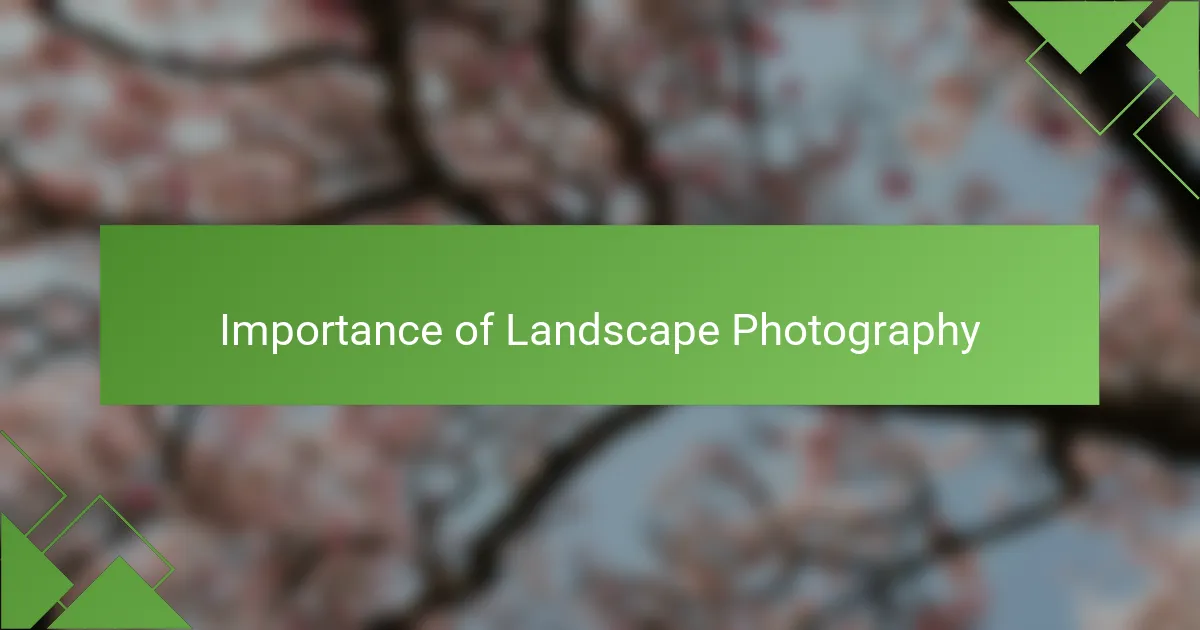
Importance of Landscape Photography
Capturing landscapes in photography is crucial for showcasing the natural beauty of a location. I believe landscape photography serves as an emotional bridge, connecting viewers with the environment. When I see a breathtaking shot of a French sunset over lavender fields, it stirs something deep within me. It reminds me of the peaceful moments I’ve spent wandering through those fields, breathing in the perfumed air.
This genre isn’t just about the scenery; it tells stories. Each photograph can evoke nostalgia, inspire wanderlust, or instill appreciation for nature. I’ve often been moved by the way light plays on the rolling hills during golden hour, creating shadows and highlights that transform the ordinary into the extraordinary.
Moreover, landscapes reflect the diversity and richness of our planet. They remind us of what we stand to lose and inspire conservation efforts. As I capture the pristine beauty of places like Mont Saint-Michel or the rugged coastline of Brittany, I feel a profound responsibility to preserve these moments for future generations.
| Aspect | Landscape Photography |
|---|---|
| Emotional Connection | Evokes feelings of nostalgia and awe |
| Storytelling | Tells compelling stories about nature and place |
| Conservation | Inspires appreciation and action for environmental preservation |
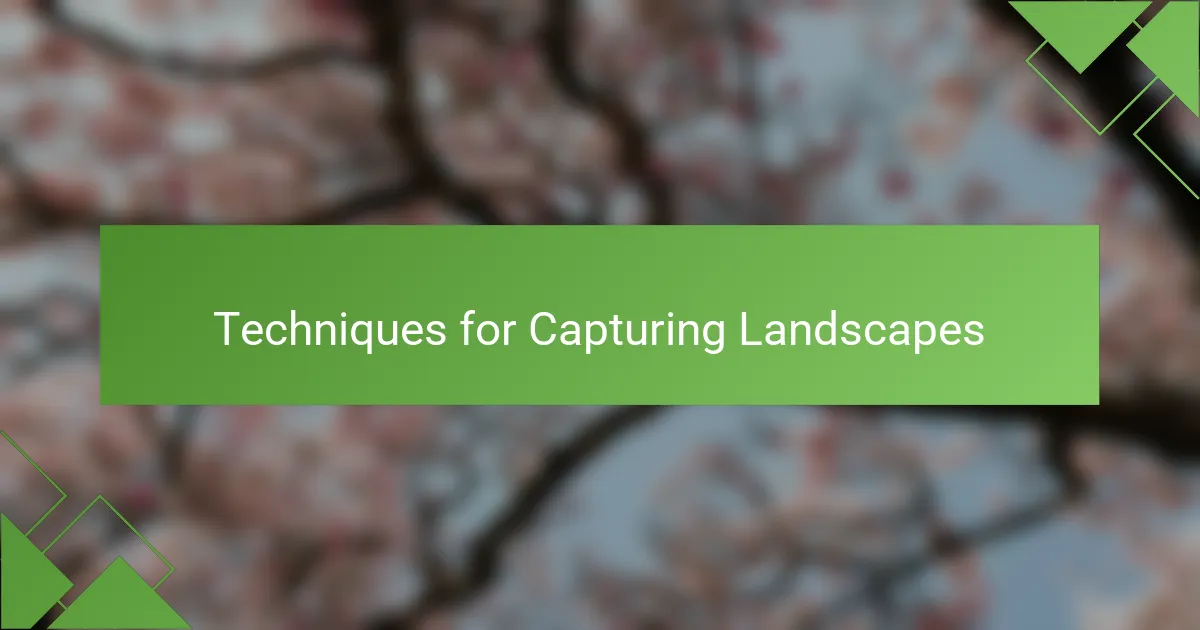
Techniques for Capturing Landscapes
When I venture into the breathtaking landscapes of France, I often find that the right techniques can make all the difference. One of the most impactful methods I’ve used is the rule of thirds. By imagining a grid that divides the frame into nine equal sections, I can position elements like the picturesque lavender fields of Provence or the dramatic cliffs of Étretat in a way that draws the viewer’s eye naturally. It’s amazing how simply aligning the horizon can elevate a shot from ordinary to extraordinary.
Equally important is the use of natural light, especially during the golden hours of sunrise and sunset. I vividly remember capturing the soft glow over Mont Saint-Michel just as the sun broke the horizon; that warm light transformed the scene into a magical painting. Experimenting with varying exposures to highlight dramatic skies or the subtle textures in the rolling vineyards can also add depth to my landscapes.
Techniques for Capturing Landscapes:
- Utilize the rule of thirds to create balanced and engaging compositions.
- Shoot during golden hours for warm and dramatic effect.
- Experiment with long exposures to capture motion in clouds or water.
- Adjust your aperture to control depth of field—shallow for isolating a subject, or deep to include expansive landscapes.
- Take advantage of foreground interest to add dimension and lead the viewer’s eye into the scene.
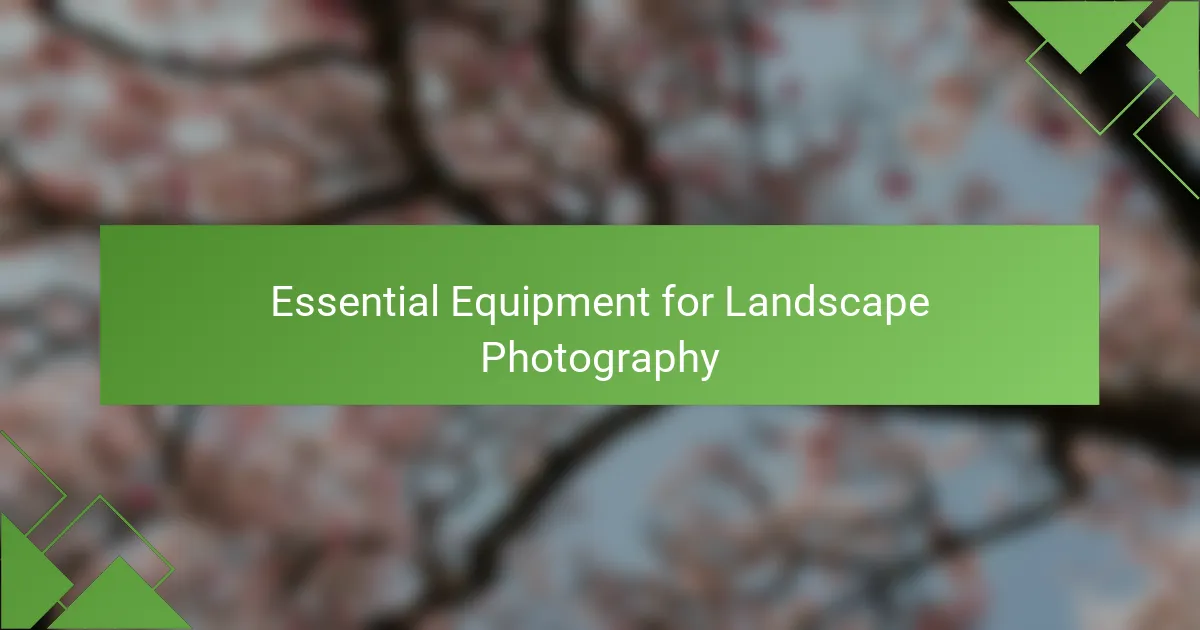
Essential Equipment for Landscape Photography
When it comes to capturing the stunning landscapes of France, the right equipment can make a world of difference. I always recommend investing in a sturdy tripod, especially for those early morning or dusk shots when the light is soft and magical. A polarizing filter can also enhance the vibrancy of the blues and greens, making those picturesque views truly pop.
For my landscape photography, I often rely on my wide-angle lens to capture the vastness of locations like the lavender fields in Provence. It allows for better depth and perspective. Sometimes, I find myself adjusting settings like aperture and shutter speed to perfect the exposure, ensuring that every detail of the scene is beautifully rendered.
Here’s a comparison of essential landscape photography equipment:
| Equipment | Description |
|---|---|
| Tripod | Provides stability for long exposures and low-light conditions. |
| Wide-Angle Lens | Captures expansive scenes, ideal for landscapes. |
| Polarizing Filter | Enhances colors and reduces glare, bringing landscapes to life. |
| ND Filter | Allows for longer exposure times, creating dreamy water effects. |
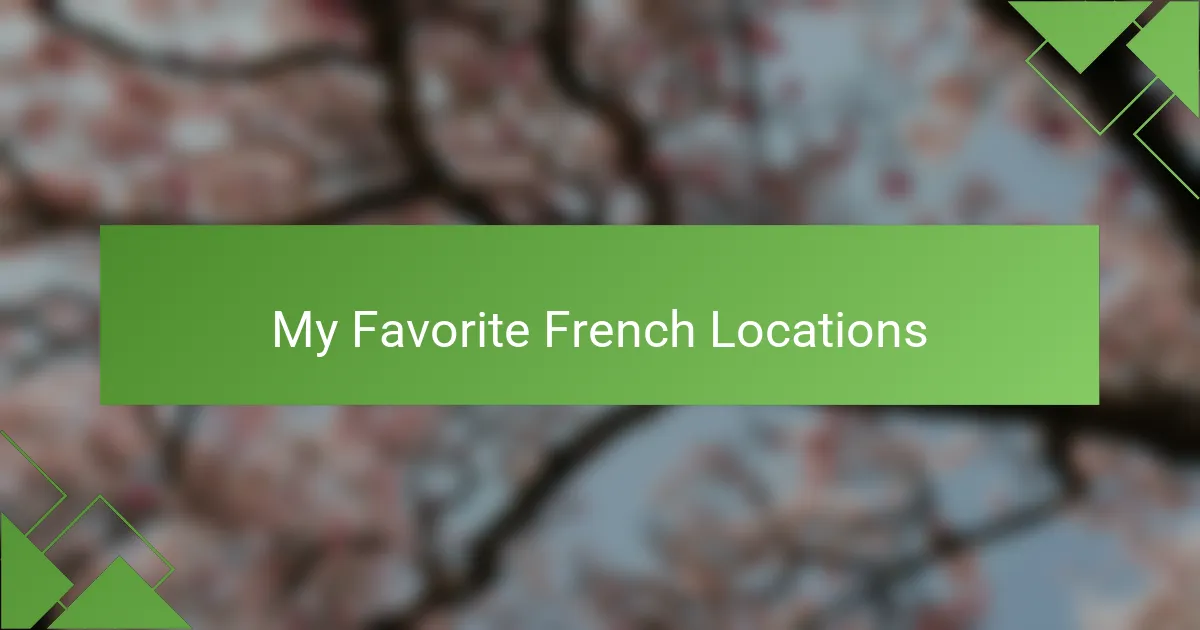
My Favorite French Locations
The rugged beauty of the Cliffs of Étretat holds a special place in my heart. I remember standing at the edge, feeling the cool sea breeze and watching the waves crash against the rocks. The sight of these iconic chalk cliffs against the dramatic sky fills me with awe every single time. Isn’t it remarkable how nature can leave you breathless?
Then there’s the enchanting village of Riquewihr, nestled in the Alsace region. Strolling through its cobblestone streets feels like stepping into a fairy tale. The vibrant half-timbered houses, with blooming flowers adorning their windows, evoke such warm feelings. Capturing this picturesque setting during the golden hour adds an extra layer of magic, making the colors pop beautifully.
Finally, I must mention the serene landscapes of the Dordogne Valley. The meandering river, surrounded by lush greenery and charming châteaux, invites exploration. It’s a place where time seems to stand still. When I photograph this landscape, I can almost hear the whispers of history reverberating through the valleys. How can one not be inspired by such a rich tapestry of beauty?
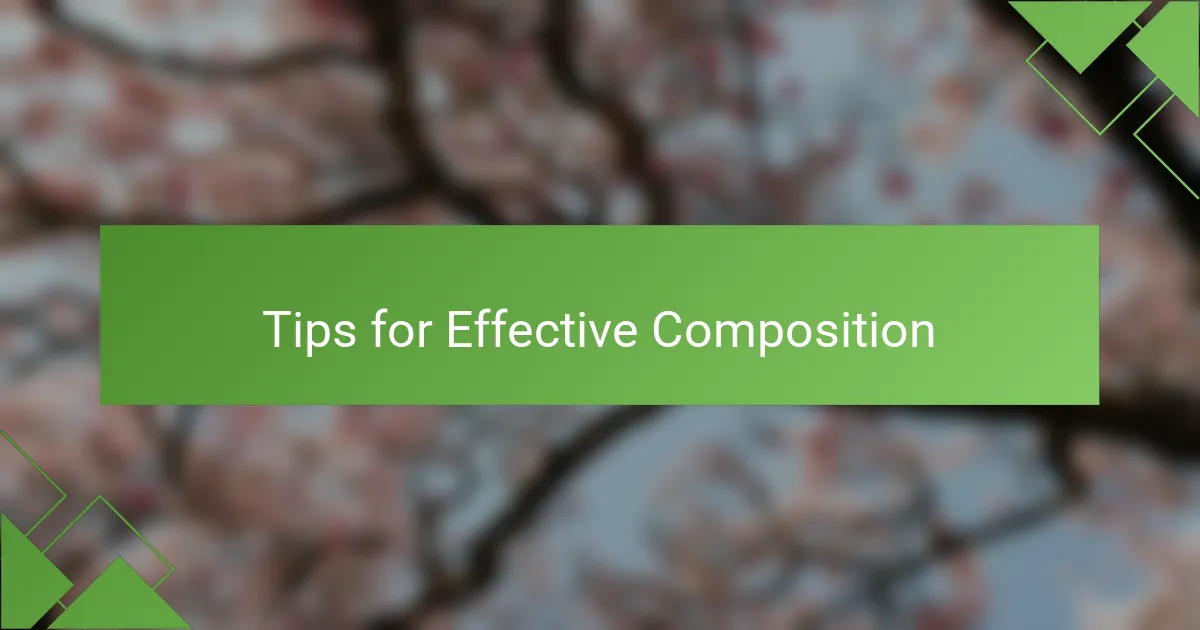
Tips for Effective Composition
When it comes to capturing the stunning landscapes of France, effective composition can really elevate your photography. I often find that using the rule of thirds helps to create a more balanced photograph. For example, when shooting the lavender fields in Provence, positioning the horizon line in the top third of the frame allows the vibrant colors of the flowers to take center stage, creating a more engaging image.
Another tip I recommend is to incorporate leading lines. I’ve had great success using pathways or rivers to draw the viewer’s eye into the frame. This technique can add depth to your photos, making them feel inviting and immersive. I once captured a winding road leading to the cliffs of Étretat, and the perspective created a sense of adventure that resonated with those who viewed the shot.
Lastly, don’t shy away from experimenting with different perspectives. I love to climb to a higher vantage point or find a unique angle to showcase a landscape from a fresh perspective. It’s amazing how changing your viewpoint can reveal details you might have otherwise missed.
| Composition Technique | Description |
|---|---|
| Rule of Thirds | Dividing your frame into thirds to create balance. |
| Leading Lines | Using natural lines to guide the viewer through the image. |
| Unique Perspectives | Changing your viewpoint for a fresh take on the landscape. |